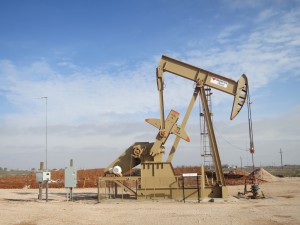Does Drop In Oil Prices Make Texas Crude Too Expensive?

Photo by Mose Buchele
A Permian Basin oil rig.
Recent financial news headlines have warned about:
- The dangers of “falling oil.”
- Or enduring the “Oil Crash of 2014.”
- Or having oil producers headed for “oblivion.”
Could it really get that bad? Maybe, if it’s like it was a few decades ago.
“There were bankruptcies everywhere,” said Ed Hirs, a Houston oil man and energy economist. “Exxon laid off 50,000 employees in 1986.”
But to mimic the great oil bust of the 1980’s, prices today have a long, long way to drop.
What may be helpful to understand now about the price of oil is how much it costs to drill for it. Naturally, the cheapest drillers will do best.
“The losers are the most expensive producers of crude oil. Right now, that’s the United States,” Hirs said.
It’s expensive to drill for oil in the United States because of hydraulic fracturing, or fracking. It’s how a majority of new wells are drilled in Texas and other states. The amount of oil that is now produced in the U.S. makes it the world’s top oil producer, even ahead of Saudi Arabia.
But while fracking has revolutionized the industry and has led to lots of new jobs, it’s costly.
It requires drilling companies to spend millions of dollars per well to truck in water, chemicals, and sand. The mixture is injected deep into underground rock formations to break them up in order to release the oil. As long as oil sells like it has been — at upwards of $100 a barrel — there is no problem.
But lately, it’s at about $80 a barrel.
“Suddenly they’re competing against some very low cost producers. The Saudis can produce oil at $25 a barrel,” Hirs said.
So that prompts the critical question: what exactly does oil have to sell for to keep Texas drillers in business?
“For the high cost operators, these prices may be a problem,” said Greg Haas, director of research at Stratas Advisors. “But for the vast majority of the wells we’ve analyzed the economics for, it looks like these prices are not a problem.”
In fact, Haas says they found that some drillers in South and West Texas could break-even with oil as low as $27 to $31 a barrel. But the majority would need prices to remain between $40 to $50 a barrel.
That’s in the ballpark of what Citigroup bank found in a report it recently did. Which is not to say there won’t be some drillers who face tough times.
Haas estimates that some Texas drillers have break-even prices in the $70 to $100 range. For those drillers, if oil prices drop below $80, it could be trouble. But it does not necessarily mean oblivion for the industry.